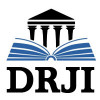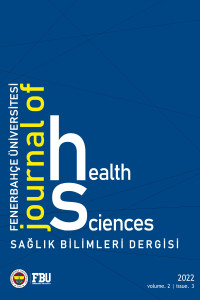Research Article
Clinical Research
Review
Case Report
Aim & Scope
Fenerbahçe University aims to publish original scientific articles in Turkish and English in the field of health sciences in Fenerbahçe University Journal of Health Sciences (FBU-JOHS), which is part of the periodicals academic publications.
Within the scope of the journal, short reports, case studies, original research articles, letters to the editor and review articles in the fields of Nutrition and Dietetics, Language and Speech Therapy, Dentistry, Midwifery, Pharmacy, Occupational Therapy, Physiotherapy and Rehabilitation, Nursing and Medicine are evaluated. The languages of the journal are Turkish and English.
Author Guidelines
Please upload the article to the system in accordance with the template in the main text file. Articles that are not uploaded in accordance with the template will be forwarded to the authors again for correction and will be evaluated later.
Click here to access the journal template.
Click here to access the submission guideline.
A. Preparation of the Article Application
Authors must follow the rules specified in the Manuscripts. Applications that do not comply with these rules are returned to the authors without being evaluated by the referees. Information on the articles to be submitted for publication and their appendices are listed below:
1. Application Letter
In this letter, it should be stated that the manuscript has been read and approved by all authors and it is the product of an original work. It should be stated whether there is a conflict of interest with any author, institution, or organization.
2. Ethics Committee Approval Certificate (If necessary, it should be attached as a separate file for research articles.)
3. Title Page (Identity information of the Author(s) must be added as a separate file.)
The name of the article, the name of the author, the institution with which he/she is affiliated, the city and country he/she lives in, the e-mail address, and the ORCID number should be submitted as a single MS Word file as the Title Page. In multi-author articles, the identity information of all authors should be specified separately on the Title Page.
- Title of the Article (Turkish and English): It should be 11 font size and bold.
3.2. Authors’ Contributions (It should be filled even if there is one author.)
The contribution rate of the researchers should be stated on the title page. The initials of the authors' names and surnames should be given, and the contributions of the authors should be indicated in the sections Topic selection, Design, Planning, Data Collection, Data Analysis, Article writing, and Critical review. This part should be added to the title page and not included in the main text.
Example:
3.3. Conflict of Interest
It should be filled even if there is only one author. Authors should state whether there is a conflict of interest with any institution or organization.
Example:
Evaluation of the Fear of COVID-19 and State-Trait Anxiety Levels of Parents Taking Their Child to Hospital with Suspected COVID-19 Name SURNAME1 1XXXX University, XXXX Faculty, XXXX Department, İstanbul, Türkiye ORCID: email: Communication Information: Address and Phone no. Corresponding Author: Authors’ Contributions: Topic selection: FY, SD; Design: FY, SD; Planning: FY, SD; Data collection: SD; Data analysis: SD, FY; Article writing: SD, FY; Critical review: FY, SD. (This part should be added to the title page and not included in the main text.) Conflict of Interest: Example: There is no conflict of interest between the authors. |
At the end of the Title Page the following information must be given:
• If there are people or institutions that contributed to the research, for example, "Supported by TÜBİTAK [grant numbers xxxx, yyyy]".
• If the article sent for publication is an article produced from a paper or thesis whose summary has been presented elsewhere but has not been published as a full text, it should be given as “Explanation.”
4. Article Text
1. Method
1.1. Purpose of the research
• If the data collection tools will be given as a sub-title, attention should be paid to the numbering.
Example:
1. Yöntem / Method
1.1. Data Collection and Data Tools
1.1.1. Sociodemographic Information Form
• All pages should be numbered consecutively, starting with the title and abstract page. Moreover, no special formal arrangements should be made.
4.1 Title of the Article, Abstract and Keywords (Turkish and English)
• The title of the article; an unstructured (in a single paragraph, without subheadings of purpose, method, findings, and conclusion) between 150-200 words (abstract) describing the purpose, scope, and main results of the research; there should be 3-5 keywords under the abstract.
• English keywords should be selected from Medical Search Heading (MesH),
• Turkish keywords should be selected from Türkiye Bilim Terimleri (http://www.bilimterimleri.com/).
• References, figures, table numbers, and footnotes should not be used in the abstract.
• Keywords should be written in alphabetical order and be separated by commas.
• Title, abstract, and keywords should be given to all articles in both languages, first in Turkish and then in English for Turkish articles, and first in English and then Turkish for English articles.
4.2. Tables
Example:
Table 1. Katılımcıların demografik bilgileri / Table 1. Katılımcıların Demografik Bilgileri
• The divided table must have a title.
• Notes section will be written in italics and with 8 font size under the table.
• Tables should be referenced in the text.
• Fractional numbers should be shown using commas (,) in Turkish texts and dots (.) in English texts.
• Tables should not have vertical borders; horizontal borders should be used at the top and bottom or to separate table sections.
4.3. Figures and Visuals
4.4 References / Endnotes
4.5. Citations
5.1. In-text references
Genel tarih ..... olarak ortaya çıkar (Foucault, 1991).
Two authors: Salas and D’Agostino (2020) described…… / End of the sentence: (Salas & D’Agostino, 2020)
Three and more authors: (Öztürk ve ark., 2022) / (Öztürk et al., 2022)
• If more than one source will be used in a sentence, sources should be listed alphabetically.
• If the group name is used for the first time in a citation, its abbreviation is used in square brackets, followed by a comma and year.
Example:
(American Psychological Association [APA], 2017)
5.2. References (APA, 2020)
• The references should be at the end of the text. Every reference cited in the text should be present in the bibliography. Likewise, every reference mentioned in the bibliography should have in-text citations.
• References are listed in alphabetical order by authors' names and in chronological order for each author.
Examples:
Book:
Author, A. A., &Author, B. B. (Year). Title of the book (edition number). Publisher Name.
• Brown, L. S. (2018). Feminist therapy (2nd ed.). American Psychological Association. https://doi.org/10.1037/0000092-000
• Burgess, R. (2019). Rethinking global health: Frameworks of power. Routledge.
Edited Book Chapter:
• Balsam, K. F., Martell, C. R., Jones, K. P., & Safren, S. A. (2019). Affirmative cognitive behavior therapy with sexual and gender minority people. In G. Y. Iwamasa & P. A. Hays (Eds.), Culturally responsive cognitive behavior therapy: Practice and supervision (2nd ed., pp. 287–314). American Psychological Association. https://doi.org/10.1037/0000119-%20012
• Weinstock, R., Leong, G. B., & Silva, J. A. (2003). Defining forensic psychiatry: Roles and responsibilities. In R. Rosner (Ed.), Principles and practice of forensic psychiatry (2nd ed., pp. 7–13). CRC Press.
Periodicals / Journal Article:
Author, A. A., & Author, B. B. (Year). Title of article. Title of Periodical, 34(2), 5–14. https://doi.org/10.000/000000
• McCauley, S. M., & Christiansen, M. H. (2019). Language learning as language use: A cross-linguistic model of child language development. Psychological Review, 126(1), 1–51. https://doi.org/10.1037/rev0000126
• Ahmann, E., Tuttle, L. J., Saviet, M., & Wright, S. D. (2018). A descriptive review of ADHD coaching research: Implications for college students. Journal of Postsecondary Education and Disability, 31(1), 17–39. https://www.ahead.org/professionalresources/publications/jped/archived-jped/jped-volume-31
• Anderson, M. (2018). Getting consistent with consequences. Educational Leadership, 76(1), 26–33.
• Burin, D., Kilteni, K., Rabuffetti, M., Slater, M., & Pia, L. (2019). Body ownership increases the interference between observed and executed movements. PLOS ONE, 14(1), Article e0209899. https://doi.org/10.1371/journal.pone.0209899
Editorial Letter
• Cuellar, N. G. (2016). Study abroad programs [Editorial]. Journal of Transcultural Nursing, 27(3), 209. https://doi.org/10.1177/1043659616638722
Conference and Congress Presentations:
Author, A. A., & Author, B. B. (Year). Title of contribution [Paper / Poster Presentation]. Conference Name, Location.
• Maddox, S., Hurling, J., Stewart, E., & Edwards, A. (2016, March 30–April 2). If mama ain’t happy, nobody’s happy: The effect of parental depression on mood dysregulation in children [Paper presentation]. Southeastern Psychological Association 62nd Annual Meeting, New Orleans, LA, United States.
• Pearson, J. (2018, September 27–30). Fat talk and its effects on state-based body image in women [Poster presentation]. Australian Psychological Society Congress, Sydney, NSW, Australia. http://bit.ly/2XGSThP
Dissertations and Theses:
Author, A. A. (2016). Title of dissertation [Unpublished doctoral dissertation / master’s thesis]. Name of Institution Awarding the Degree.
• Harris, L. (2014). Instructional leadership perceptions and practices of elementary school leaders [Unpublished doctoral dissertation]. University of Virginia.
Dissertation or thesis from a database:
• Hollander, M. M. (2017). Resistance to authority: Methodological innovations and new lessons from the Milgram experiment (Publication No. 10289373) [Doctoral dissertation, University of Wisconsin–Madison]. ProQuest Dissertations and Theses Global.
Website:
Author, A. A. (2013). Title of work. Site Name. Retrieved December 22, 2020, from https://xxxxx
• The BBC (2022). http://www.bbc.co.uk
• Avramova, N. (2019, January 3). The secret to a long, happy, healthy life? Think age-positive. CNN. https://www.cnn.com/2019/01/03/health/respect-towardelderly-leads-to-long-life-intl/index.html
• Centers for Disease Control and Prevention. (2018, January 23). People at high risk of developing flu-related complications. https://www.cdc.gov/flu/about/disease/high_risk.htm
• Boddy, J., Neumann, T., Jennings, S., Morrow, V., Alderson, P., Rees, R., & Gibson, W. (n.d.). Ethics principles. The Research Ethics Guidebook: A Resource for Social Scientists. http://www.ethicsguidebook.ac.uk/EthicsPrinciples
Ethical Principles and Publication Policy
All authors who submit articles for evaluation and publication approve and agree to comply with the International Commission of Publication Ethics (COPE), Good Clinical Practices Guidelines, Declaration of Helsinki, and comply with them. Manuscripts sent to the journal for review are evaluated within the scope of International Standards, taking into account the recommendations of the International Committee of Medical Journal Editors (ICMJE) and the principles of the International Committee of Publication Ethics (COPE).
Click for Ethical Principles and Publication Process.
• Articles published as an article or in another format (book, book chapter, printed paper, etc.), accepted for publication or in the process of evaluation are not accepted for evaluation.
• For articles with more than one author, articles without the approval of each author are not accepted.
• For studies that require 'Ethics Committee Approval', the approval document must be submitted at the same time of application.
• The similarity (plagiarism) rate of the submitted articles must be below 20%. (Similarity report can be obtained from turnitin.com, intihal.net, ithenticate.com etc.)
Price Policy
Fenerbahce University Journal of Health Sciences does not charge any fees from the authors after the application or under any name.
Indexes
Journal Boards
Editor-in-Chief


Editor




Co-Editor
Editorial Board



Section Editors






Foreign Language Editors
Journal Secretariat












